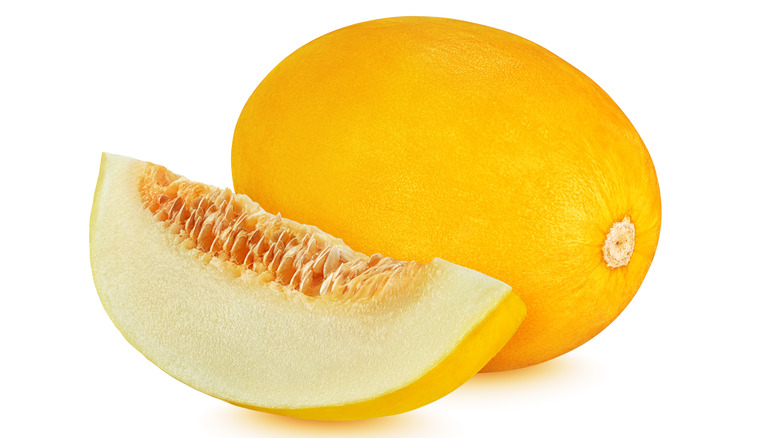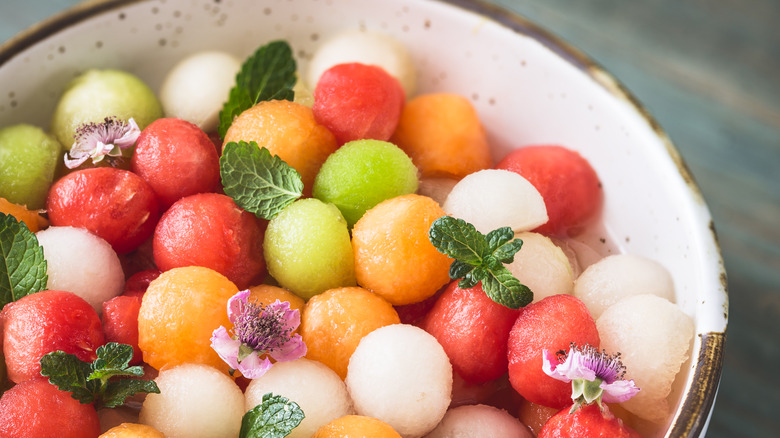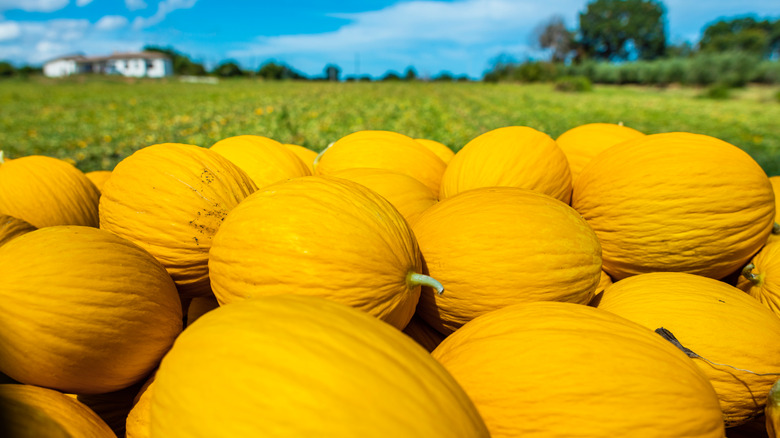What Makes Canary Melon Unique
So you thought you knew all the kinds of melon? Think again. There are many types of melon out there with a variety of textures, sizes, wonderful flavors, and of course colors. One of these melons, in particular, is known and named for its bright hue: the canary melon.
Canary melon, sometimes known as Juan Canary melon, Jaune des Canaries, or Spanish Melon, is a sweet variety of muskmelon in the Cucurbitaceae family, according to Specialty Produce. These melons are known for their bright yellow rinds, reminiscent of the bird for which they're named. The rinds are smooth, though tough with a waxy texture when ripe that will slowly corrugate, or wrinkle, with age. The flesh of the melon is a white or cream color with undertones of green, and soft and juicy. Like many similar melons, there is also a circular cavity in the center with seeds that are discarded before eating. They are typically about five pounds, with a four- to five-inch diameter and a slightly oblong shape, similar to an American football.
While this particular melon's specific origins are unknown, its muskmelon family originates from the areas around the Middle East and the Mediterranean. Canary melons are particularly popular in Asia but can be found on most continents in both hemispheres. In the United States, most are grown in California.
Eating and cooking canary melons
So how does it taste? According to Fruitstand, canary melons have a mild musk and bright flavor reminiscent of cantaloupe and Asian pears, which Specialty Produce adds is both sweet and tangy. Gardening Know How also likens the melon to the flavor of honeydew. Like other common melons, canary melons are great when sliced and eaten fresh, sprinkled with salt or ginger as a snack, or as an added element to a charcuterie board. The raw melon can be added to fruit salads, blended into smoothies or frozen granitas, or incorporated as a fruity element to cocktails, fresh salsas, and ceviche. Like most melons, it pairs well with other flavors like mint, basil, cilantro, cucumber, cheeses, and other fruits.
Fruitstand also writes that the sugar content of the melon also makes it a great option for grilling, which will caramelize the melon and bring out the sweet flavor. Canary melon is also great for making jams and fruity fillings for baking.
But don't let its sweet composition fool you — the fruit is nutritious, too. According to Specialty Produce, canary melons are a great source of fiber, the antioxidant vitamin C, vitamin A, and potassium.
Buying and growing canary melons
Aching to try a slice now? Canary melons are in season from summer to around mid-fall, and can sporadically be found at most grocers. For picking out a ripe canary melon, Specialty Produce suggests that it should feel heavy for its size and emit a slightly tropical aroma.
Fruitstand writes that while canary melons are typically harvested ripe, they can continue to mature after harvesting. They can be stored whole on the counter for a week once ripe, or about two weeks in the fridge. Sliced melon can be stored in an airtight container in the fridge for two to three days.
If you're interested in growing melons in your home garden, seeds can also be found in online catalogs. According to Gardening Know How, canary melons require plenty of heat, sunshine, and water in a growing period of 80 to 90 days. If planting directly outdoors, wait until all risk of frost has passed. You can also choose to start the steeds indoors before transplanting them outdoors when warm enough.
Whether you decide to pick it up at the grocery store or try to grow it on your own, with its sweet taste and aroma, you'll definitely want to add the canary melon to your fruity dishes. With it's bright, sunshine-colored rind, how could you miss it?


